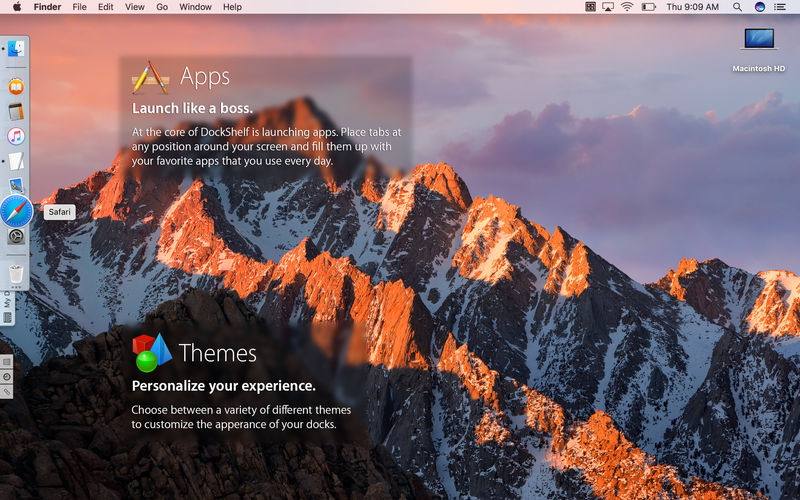Dockshelf 1 5 0
New as of 0.5.0
Following a deploy, dokku will wait 10 seconds before routing traffic to the new container to give your application time to boot up. If the application is not running after this time, then the deploy is failed and your old container will continue serving traffic. You can modify this value globally or on a per-application basis:
TOPICS 1.5.0 Dockshelf mac 应用程序 快速启动 Previous: Vector Magic Desktop Edition 1.20 (+fix for macOS 10.12) 矢量图转换成位图 Next: Otomatic for mac 1.1.2.187 互联网内容关注工具.
- This means running a scan for malware, cleaning your hard drive using 1 cleanmgr and 2 sfc /scannow, 3 uninstalling programs that you no longer need, checking for Autostart programs (using 4 msconfig) and enabling Windows' 5 Automatic Update. Always remember to perform periodic backups, or at.
- RGB Color Examples 0/0/0 0/0/0.1 0/0/0.2 0/0/0.3 0/0/0.4 0/0/0.5 0/0/0.6 0/0/0.7 0/0/0.8 0/0/0.9. 0/0.9/0.6 0/0.9/0.7 0/0.9/0.8 0/0.9/0.9 0/0.9/1 0/1/0 0/1/0.1 0/1/0.
You can also choose to skip checks completely on a per-application basis:

Dokku will wait 60 seconds before stopping the old container so that existing connections are given a chance to complete. You can modify this value globally or on a per-application basis:
Note that during this time, multiple containers may be running on your server, which can be an issue for memory-hungry applications on memory-constrained servers.
Checks
If your application needs a longer period to boot up - perhaps to load data into memory, or because of slow boot time - you may also use dokku's checks functionality to more precisely check whether an application can serve traffic or not.
To specify checks, add a CHECKS file to the root of your project directory. The CHECKS file should be plain text and may contain:
- Check instructions
- Settings (NAME=VALUE)
- Comments (lines starting with #)
- Empty lines
For dockerfile-based deploys, the file must be in /app/CHECKS within the container. /app is used by default as the root container directory for buildpack-based deploys.
Check Instructions
The format of a check instruction is a path or relative URL, optionally followed by the expected content:
The CHECKS file can contain multiple checks:
To check an application that supports multiple hostnames, use relative URLs that include the hostname:
You can also specify the protocol to explicitly check HTTPS requests:
Check Settings
The default behavior is to wait for 5 seconds before running the checks, to timeout the checks after 30 seconds, and to attempt the checks 5 times. If the checks fail 5 times, the deployment is considered failed and the old container will continue serving traffic.
Dockshelf 1 5 0 45
You can change the default behavior by setting WAIT, TIMEOUT, and ATTEMPTS to different values in the CHECKS file:
You can also override the default WAIT, TIMEOUT, and ATTEMPTS variables for the global dokku installation:
If your application runs multiple processes (a background worker configured in your Procfile, for example) and you have checks to ensure that your web application has booted up, you may want to disable the default check wait time for that application to avoid the 10 second wait per non-web process:
Example: Successful Rails Deployment

In this example, a Rails application is successfully deployed to dokku. The initial round of checks fails while the server is starting, but once it starts they succeed and the deployment is successful. WAIT is set to 10 because our application takes a while to boot up. ATTEMPTS is set to 6, but the third attempt succeeds.
CHECKS file
For this check to work, we've added a line to config/routes.rb that simply returns a string:
Deploy Output
Note: The output has been trimmed for brevity
Example: Failing Rails Deployment
In this example, a Rails application fails to deploy. The reason for the failure is that the postgres database connection fails. The initial checks will fail while we wait for the server to start up, just like in the above example. However, once the server does start accepting connections, we will see an error 500 due to the postgres database connection failure.
Dockshelf 1 5 0 34
Once the attempts have been exceeded, the deployment fails and we see the container output, which shows the Postgres connection errors.
CHECKS file
1.5 21 Savage
The check to the root url '/' would normally access the database.
1.5 As A Fraction
Deploy Output
Note: The output has been trimmed for brevity